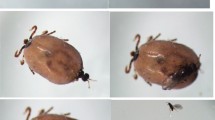Abstract
Patterns of attacking hosts by two closely related species of ixodid ticks (Ixodes persulcatus and I. ricinus) were compared in parallel field tests. The ability of active unfed adults of both sexes to adhere to a flannel flag dragged over grass vegetation and to remain on the flag during this process were estimated. The tests were conducted under two temperature conditions, 6–10°C and 17–22°C. In all test versions, adults of I. persulcatus were more successful both in adhering to the flag and in remaining on it. There were no consistent differences between males and females of the same species. The results demonstrated a differing ability of successful attack in both tick species. This ability is a complex derivative of the tick activity and aggressiveness. An attempt is made to analyse the latter phenomenon, which is considered as a general one for all bloodsucking arthropods. The aggressiveness of arthropods should be taken into account as one of the leading factors influencing the sampling results.
Similar content being viewed by others
References
Babenko, L.V., Bush, M.A., Arumova, E.A. and Skadinsh, E.A. 1979. Scasonal changes in the insemination rate of female Ixodes ricinus L. and Ixodes persulcatus P. Sch. prior to arriving on a host, and the significance of this phenomenon in the life of tick populations. Med. Parazitol. Parazit. Bolezni (Moscow), No. 5: 71–79 (in Russian).
Barnard, D.R. 1991. Mechanisms of host-tick contact with special reference to Amblyomma americanum (Acari: Ixodidae) in beef cattle forage areas. J. Med. Entomol., 28: 557–564.
Carpenter, S.J. and LaCasse, W.J. 1955. Mosquitoes of North America (north of Mexico). University of California Press, Berkeley, 360 pp.
Chandler, J.A., Parsons, J., Boreham, P.F.L. and Gill, G.S. 1977. Seasonal variations in the proportions of mosquitoes feeding on mammals and birds at a heronry in western Kenya. J. Med. Entomol., 14: 233–240.
Dewsbury, D.A. 1978. Comparative animal behavior. McGraw-Hill Book Co., N.Y. etc., 452 pp.
Elizarov, Yu. A. and Vasyuta, A.A. 1976. Distant orientation of Ixodes persulcatus ticks to the host's attractant factors. Parazitol. (Leningrad), 10: 136–141 (in Russian).
Falco, R.C. and Fish, D. 1991. Horizontal movement of adult Ixodes dammini (Acari: Ixodidae) attracted to CO2-baited traps. J. Med. Entomol., 28: 726–729.
Filippova, N.A. 1977. Ixodid ticks of the subfamily Ixodinae. Nauka, Leningrad, 396 pp (in Russian).
Filippova, N.A. (Editor), 1985. The taiga tick Ixodes persulcatus Schulze. Nauka, Leningrad, 416 pp. (in Russian).
Kheisin, E.M. 1950. On the northern limit of distribution of Ixodes ricinus and I. persulcatus ticks in Karelo-Finskaya S.S.R. Zoolog. Zhurnal (Moscow), 29: 572–574 (in Russian).
Killick-Kendrick, R. and Molyneux, D.H. 1990. Interrupted feeding of vectors. Parasitology Today, 6: 188–189.
Kolonin, G.V., Kiselev, A.N. and Bolotin, E.I. 1975. An experience of absolute sampling of pasture ixodid ticks (Parasitiformes, Ixodidae) on the eastern slope of the Sikhote-Alin'Mountains. Parazitol. (Leningrad), 9: 419–424 (in Russian).
Leonovich, S.A. 1989. The ethology of the taiga tick, Ixodes persulcatus, during the period of spring activity. Parazitol. (Leningrad), 23: 11–19 (in Russian).
Moiseenko, N.M. 1958. Materials on the biology of the tick-borne encephalitis vector, Ixodes persulcatus P.Sch., in the Khabarovsk Territory. Abstract of Ph.D. dissert. Vladivostok, 16 pp. (in Russian).
Molyneux, D.H. and Jefferies, D. 1986. Feeding behaviour of pathogen-infected vectors. Parasitology, 92: 721–736.
Nutall, P.A., Jones, L.D. and Davies, C.R. 1991. The role of arthropod vectors in arbovirus evolution. In: K.F.Harris (Editor), Advances in disease vector research, vol. 8 Springer-Verlag, New York etc. pp. 15–45.
Okulova, N.M. 1978. Vertical and horizontal movements of ixodid ticks in forests depending on the air temperature and humidity. Ekologiya (Sverdlovsk), No. 2: 44–48 (in Russian).
Okulova, N.M. and Chumakov, M.P. 1976. Features of natural foci in relation to the problem of heightened pathogenicity of the tick-borne encephalitis agent in the Far East. In: Ecology of viruses. Materials of the 10th Symposium. Baku, pp. 121–122 (in Russian).
Randolph, S.E., Rogers, D.J., Dransfield, R.D. and Brightwell, R. 1991. Trap-catches, nutritional condition and the timing of activity of the tsetse fly Glossina longipennis (Diptera: Glossinidae). Bull. Entomol. Res., 81: 455–464.
Repkina, L.V. 1963. Occurrence of inseminated unfed females of Ixodes persulcatus P.Sch. in nature. Med. Parazitol. Parazit. Bolezni (Moscow), 42: 237–239 (in Russian).
Sonenshine, D.E. 1975. Influence of host-parasite interactions on the population dynamics of ticks. Misc. Public. Entomol. Soc. America, 9: 243–249.
Southwood, T.R.E. 1966. Ecological methods with particular reference to the study of insect populations. Methuen & Co. Ltd., London, 391 pp.
Uspensky, I.V., Kachanko, N.I. and Repkina, L.V. 1978. Materials on the ecology of ixodid ticks in the northern part of the Amur Region. Zoolog. Zhurnal (Moscow), 57: 391–397 (in Russian).
Uspensky, I.V. and Repkina, L.V. 1978. Observations on mating and insemination in Ixodes persulcatus. Zoolog. Zhurnal (Moscow), 57: 1092–1095 (in Russian).
Uspensky, I. and Rubina, M. 1992. Host substitution by Ixodes persulcatus (Acari: Ixodidae) larvae in the years of deep depression in the abundance of small mammals. Folia Parasitol. (Praha), 39: 171–176.
Walker, E.D. and Edman, J.D. 1985. The influence of host defensive behavior on mosquito (Diptera: Culicidae) biting persistence. J. Med. Entomol., 22: 370–372.
Yuval, B., Deblinger, R.D. and Spielman, A. 1990. Mating behavior of male deer ticks Ixodes dammini (Acari: Ixodidae). J. Insect Behavior, 3: 765–772.
Author information
Authors and Affiliations
Rights and permissions
About this article
Cite this article
Uspensky, I. Ability of successful attack in two species of ixodid ticks (Acari: Ixodidae) as a manifestation of their aggressiveness. Exp Appl Acarol 17, 673–683 (1993). https://doi.org/10.1007/BF00058507
Accepted:
Issue Date:
DOI: https://doi.org/10.1007/BF00058507




